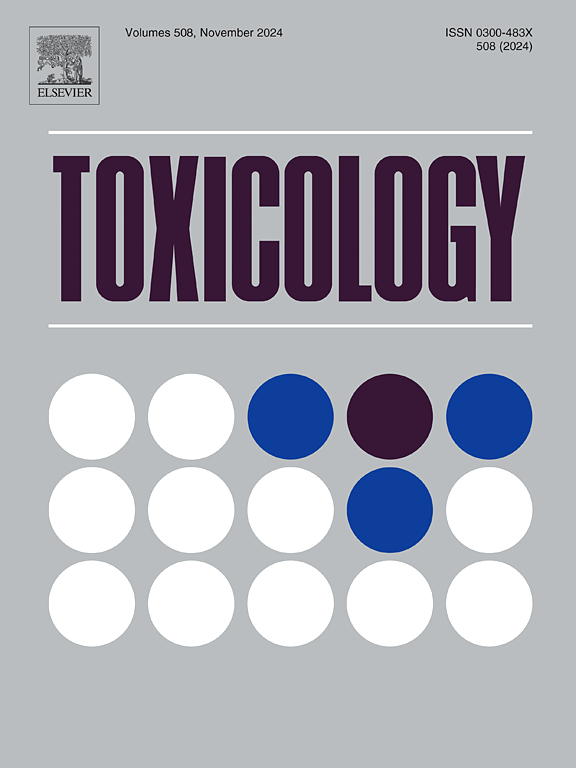长期口服非那雄胺和不同剂量米诺地尔可诱导成年Balb/c小鼠睾丸和附睾改变。
IF 4.6
3区 医学
Q1 PHARMACOLOGY & PHARMACY
引用次数: 0
摘要
口服非那雄胺和外用米诺地尔已被批准用于雄激素性脱发的治疗,而低剂量口服米诺地尔已成为一种有前途的标签外替代方案。尽管其血管扩张和雄激素调节特性,米诺地尔对男性生殖健康的影响仍然知之甚少。鉴于米诺地尔越来越多的超说明书使用和潜在的生殖影响,本研究旨在评估口服米诺地尔对成年Balb/c小鼠睾丸和附睾的组织病理学、激素和氧化应激影响。120只动物被分为6组(n=20),每日口服水、载药、非那雄胺(5mg/kg)或米诺地尔(2.5、5、7.5mg/kg)。一半在42天后被安乐死,其余的在84天后被安乐死。在第42天,米诺地尔和非那雄胺均诱导睾丸结构改变,包括精质上皮空泡化,精质上皮高度降低,间质细胞比例增加。在米诺地尔治疗组中,这些改变伴随着血清雌二醇水平下降和氧化失衡,表明这些可能是米诺地尔诱导生殖毒性的潜在机制。84天后,尽管雌二醇水平和氧化状态没有明显变化,但睾丸结构改变持续存在,其特征是在非那雄胺和米诺地尔治疗后,精管上皮继续空泡化,精管上皮比例下降。虽然没有观察到剂量依赖的米诺地尔效应,但5mg/kg的剂量更频繁地引起改变。在两个时间点,两种药物均可发现附睾组织学改变。然而,只有非那雄胺显著减少精子转运时间(42天和84天)和尾端精子数量(84天)。这些结果表明,虽然米诺地尔和非那雄胺都能引起更广泛的睾丸改变,但非那雄胺会显著影响附睾功能。这项研究强调了长期口服米诺地尔的潜在生殖风险,并强调了临床研究评估其对男性生殖健康安全性的重要性,特别是对育龄个体。本文章由计算机程序翻译,如有差异,请以英文原文为准。
Long-term oral exposure to finasteride and different doses of minoxidil induces testicular and epididymal alterations in adult Balb/c mice
Oral finasteride and topical minoxidil are approved treatments for androgenetic alopecia, while low-dose oral minoxidil has emerged as a promising off-label alternative. Despite its vasodilatory and androgen-modulating properties, the minoxidil effects on male reproductive health remain poorly understood. Given its growing off-label use and potential reproductive impact, this study aimed to evaluate the histopathological, hormonal, and oxidative stress effects of oral minoxidil on the testes and epididymides of adult Balb/c mice. A total of 120 animals were divided into six groups (n = 20) receiving daily oral doses of water, vehicle, finasteride (5 mg/kg), or minoxidil (2.5, 5, or 7.5 mg/kg). Half were euthanized after 42 days and the remainder after 84 days of treatment. On the 42nd day, both minoxidil and finasteride induced testicular structural alterations, including vacuolization of the seminiferous epithelium, reduction in seminiferous epithelium height, and increase in the proportion of Leydig cells. In the minoxidil-treated groups, these alterations were accompanied by decreased serum estradiol levels and oxidative imbalance, suggesting these might be underlying mechanisms of minoxidil-induced reproductive toxicity. After 84 days, although no significant changes were observed in the estradiol levels and oxidative status, testicular structural alterations persisted, characterized by continued vacuolization of the seminiferous epithelium and decreased seminiferous epithelium proportion after finasteride and minoxidil treatments. Although no dose-dependent minoxidil effect was observed, the dose of 5 mg/kg more frequently induced alterations. Histological epididymal changes were identified with both drugs at both time points. However, only finasteride significantly reduced sperm transit time (at 42 and 84 days) and cauda sperm count (at 84 days). These results suggest that while both minoxidil and finasteride induce broader testicular alterations, finasteride significantly affects epididymal function. This study highlights potential reproductive risks associated with long-term oral minoxidil use and emphasizes the importance of clinical studies assessing its safety in male reproductive health, particularly in individuals of reproductive age.
求助全文
通过发布文献求助,成功后即可免费获取论文全文。
去求助
来源期刊

Toxicology
医学-毒理学
CiteScore
7.80
自引率
4.40%
发文量
222
审稿时长
23 days
期刊介绍:
Toxicology is an international, peer-reviewed journal that publishes only the highest quality original scientific research and critical reviews describing hypothesis-based investigations into mechanisms of toxicity associated with exposures to xenobiotic chemicals, particularly as it relates to human health. In this respect "mechanisms" is defined on both the macro (e.g. physiological, biological, kinetic, species, sex, etc.) and molecular (genomic, transcriptomic, metabolic, etc.) scale. Emphasis is placed on findings that identify novel hazards and that can be extrapolated to exposures and mechanisms that are relevant to estimating human risk. Toxicology also publishes brief communications, personal commentaries and opinion articles, as well as concise expert reviews on contemporary topics. All research and review articles published in Toxicology are subject to rigorous peer review. Authors are asked to contact the Editor-in-Chief prior to submitting review articles or commentaries for consideration for publication in Toxicology.
 求助内容:
求助内容: 应助结果提醒方式:
应助结果提醒方式:


